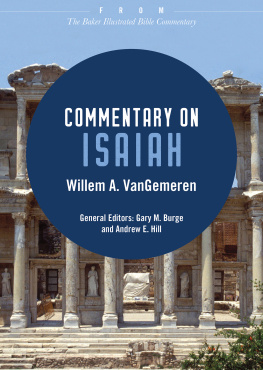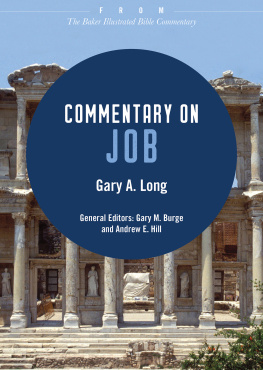Douglas J. Moo - Commentary on James: From The Baker Illustrated Bible Commentary
Here you can read online Douglas J. Moo - Commentary on James: From The Baker Illustrated Bible Commentary full text of the book (entire story) in english for free. Download pdf and epub, get meaning, cover and reviews about this ebook. year: 2019, publisher: Baker Publishing Group, genre: Religion. Description of the work, (preface) as well as reviews are available. Best literature library LitArk.com created for fans of good reading and offers a wide selection of genres:
Romance novel
Science fiction
Adventure
Detective
Science
History
Home and family
Prose
Art
Politics
Computer
Non-fiction
Religion
Business
Children
Humor
Choose a favorite category and find really read worthwhile books. Enjoy immersion in the world of imagination, feel the emotions of the characters or learn something new for yourself, make an fascinating discovery.
- Book:Commentary on James: From The Baker Illustrated Bible Commentary
- Author:
- Publisher:Baker Publishing Group
- Genre:
- Year:2019
- Rating:4 / 5
- Favourites:Add to favourites
- Your mark:
- 80
- 1
- 2
- 3
- 4
- 5
Commentary on James: From The Baker Illustrated Bible Commentary: summary, description and annotation
We offer to read an annotation, description, summary or preface (depends on what the author of the book "Commentary on James: From The Baker Illustrated Bible Commentary" wrote himself). If you haven't found the necessary information about the book — write in the comments, we will try to find it.
Commentary on James: From The Baker Illustrated Bible Commentary — read online for free the complete book (whole text) full work
Below is the text of the book, divided by pages. System saving the place of the last page read, allows you to conveniently read the book "Commentary on James: From The Baker Illustrated Bible Commentary" online for free, without having to search again every time where you left off. Put a bookmark, and you can go to the page where you finished reading at any time.
Font size:
Interval:
Bookmark:
2012 by Baker Publishing Group
Published by Baker Books
a division of Baker Publishing Group
P.O. Box 6287, Grand Rapids, MI 49516-6287
www.bakerbooks.com
Ebook short created 2019
Previously published in The Baker Illustrated Bible Commentary edited by Gary M. Burge and Andrew E. Hill in 2012
All rights reserved. No part of this publication may be reproduced, stored in a retrieval system, or transmitted in any form or by any meansfor example, electronic, photocopy, recordingwithout the prior written permission of the publisher. The only exception is brief quotations in printed reviews.
Library of Congress Cataloging-in-Publication Data is on file at the Library of Congress, Washington, DC.
ISBN 978-1-4934-2477-1
Unless otherwise indicated, Scripture quotations are from the Holy Bible, New International Version. NIV. Copyright 1973, 1978, 1984, 2011 by Biblica, Inc. Used by permission of Zondervan. All rights reserved worldwide. www.zondervan.com. The NIV and New International Version are trademarks registered in the United States Patent and Trademark Office by Biblica, Inc.
Scripture quotations labeled ESV from The Holy Bible, English Standard Version (ESV), copyright 2001 by Crossway, a publishing ministry of Good News Publishers. Used by permission. All rights reserved. ESV Text Edition: 2007
Scripture quotations labeled NASB are from the New American Standard Bible, copyright 1960, 1962, 1963, 1968, 1971, 1972, 1973, 1975, 1977, 1995 by The Lockman Foundation. Used by permission. www.lockman.org
Scripture quotations labeled NIV 1984 are from the HOLY BIBLE, NEW INTERNATIONAL VERSION. NIV. Copyright 1973, 1978, 1984 by International Bible Society. Used by permission of Zondervan. All rights reserved.
Scripture quotations labeled NJPS are from the New Jewish Publication Society Version 1985 by The Jewish Publication Society. All rights reserved.
Scripture quotations labeled NKJV are from the New King James Version. Copyright 1982 by Thomas Nelson, Inc. Used by permission. All rights reserved.
Scripture quotations labeled NLT are from the Holy Bible , New Living Translation, copyright 1996, 2004, 2007 by Tyndale House. Used by permission of Tyndale House Publishers, Inc., Carol Stream, Illinois 60188. All rights reserved.
Scripture quotations labeled NRSV are from the New Revised Standard Version of the Bible, copyright 1989, by the Division of Christian Education of the National Council of the Churches of Christ in the United States of America. Used by permission. All rights reserved.
Scripture quotations labeled RSV are from the Revised Standard Version of the Bible, copyright 1952 [2nd edition, 1971] by the Division of Christian Education of the National Council of the Churches of Christ in the United States of America. Used by permission. All rights reserved.
Unless otherwise indicated, photos, illustrations, and maps are copyright Baker Photo Archive.
| ANET | Ancient Near Eastern Texts Relating to the Old Testament . Edited by J. B. Pritchard. 3rd ed. Princeton, 1969 |
| BDAG | Bauer, W., F. W. Danker, W. F. Arndt, and F. W. Gingrich. Greek-English Lexicon of the New Testament and Other Early Christian Literature. 3rd ed. Chicago, 1999 |
| ca. | circa (about, approximately) |
| cf. | compare |
| chap(s). | chapter(s) |
| COS | The Context of Scripture . Edited by W. W. Hallo. 3 vols. Leiden, 1997 |
| e.g. | for example |
| ESV | English Standard Version |
| HALOT | Koehler, L., W. Baumgartner, and J. J. Stamm. The Hebrew and Aramaic Lexicon of the Old Testament. Translated and edited under the supervision of M. E. J. Richardson. 5 vols. Leiden, 19942000 |
| HCSB | Holman Christian Standard Bible |
| i.e. | that is |
| KJV | King James Version |
| NASB | New American Standard Bible |
| NEB | New English Bible |
| NET | New English Translation |
| NIV | New International Version (2011 edition) |
| NIV 1984 | New International Version (1984 edition) |
| NJB | New Jerusalem Bible |
| NJPS | The Tanakh: The Holy Scriptures: The New JPS Translation according to the Traditional Hebrew Text |
| NKJV | New King James Version |
| NLT | New Living Translation |
| NRSV | New Revised Standard Version |
| RSV | Revised Standard Version |
| TDOT | Theological Dictionary of the Old Testament . Edited by G. J. Botterweck and H. Ringgren. Translated by J. T. Willis, G. W. Bromiley, and D. E. Green. 8 vols. Grand Rapids, 1974 |
| TNIV | Todays New International Version |
Douglas J. Moo
Introduction
Author
The writer of the letter identifies himself simply as James, a servant of God and of the Lord Jesus Christ (1:1). Who is this James? Of the four men with this name mentioned in the New Testament, only two are significant enough to have identified themselves as simply as does the author of this letter: James the son of Zebedee, who was one of the twelve apostles (Mark 1:19), and James the Lords brother (Gal. 1:19), who early on became the leader of the Jerusalem church (cf. Acts 15:13; 21:18; Gal. 2:9). Although a few scholars have thought that the son of Zebedee could be the author, his early martyrdom (AD 44; cf. Acts 12:2) probably removes him from consideration. Still others think that the good, almost literary Greek of the letter, along with the way the author handles the topic of justification (2:1426), makes it likely that someone toward the end of the first century wrote the letter and ascribed it to James. But this theory is unnecessary and calls into question the honesty of the writer. There is every reason to accept the widespread opinion of the early church that James the brother of the Lord wrote this letter.
Although this view is contested, it is probable that James was a younger brother of Jesus, born to Joseph and Mary after the birth of Jesus. Not a believer during Jesuss earthly ministry (cf. John 7:5), James was probably converted as a result of a postresurrection appearance (1 Cor. 15:7). His wise leadership of the Jewish Christian church (see Acts 15:622), along with his piety and respect for ancestral traditions, earned him the title the Just in both Jewish and Christian history.

[ Copyright Baker Photo Archive. Courtesy of the British Museum. ]
Audience, Date, and Occasion
James is classed among the General Epistles of the New Testament, those letters that are not addressed to specific churches (e.g., 1 Corinthians) or individuals (e.g., 1 Timothy). But this does not mean that James had no definite readers in mind as he wrote. The letter is addressed to the twelve tribes scattered among the nations (1:1). From its original application, the phrase twelve tribes came to designate the complete regathering of Gods people that would take place in the messianic age (cf. Isa. 49:6; Ezek. 47:13). James, then, uses this title to remind his readers that they belong to that new creation, the church, that God has brought into being on the basis of faith in his Son (cf. Matt. 16:18). These twelve tribes have been scattered or dispersed among the nations. What is meant by this? In one sense, all Gods people, as aliens and exiles, living apart from our true heavenly home, have been scattered in this world (cf. 1 Pet. 1:1). But the word scatter and its noun form, those scattered, or dispersion, was often used to designate Jews living outside Palestine. It may be that James uses the word with this more specific meaning. Suggestive here is the reference in Acts 11:19 to those early Jewish Christians in Jerusalem who were forced to flee the city because of persecution and engaged in evangelism among Jews as far as Phoenicia, Cyprus and Antioch. Could this not furnish a plausible background for the circumstances of the Letter of James? Forced to live away from their home church, these scattered parishioners required exhortation and advice on issues they were facing. What is more natural than that their spiritual guide send them a pastoral letter?
Font size:
Interval:
Bookmark:
Similar books «Commentary on James: From The Baker Illustrated Bible Commentary»
Look at similar books to Commentary on James: From The Baker Illustrated Bible Commentary. We have selected literature similar in name and meaning in the hope of providing readers with more options to find new, interesting, not yet read works.
Discussion, reviews of the book Commentary on James: From The Baker Illustrated Bible Commentary and just readers' own opinions. Leave your comments, write what you think about the work, its meaning or the main characters. Specify what exactly you liked and what you didn't like, and why you think so.


















